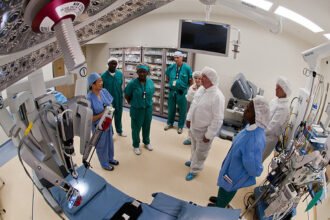Preventable medical errors in hospitals persist as the third leading cause of death in the United States, after heart disease and cancer. This alarming reality only stresses the importance of preparedness, quick decision-making, and sufficient practice in healthcare around the world. Apart from loss of human lives, what also matters is the loss of trust in the healthcare system and cost of medical liabilities.
Preventable medical errors in hospitals persist as the third leading cause of death in the United States, after heart disease and cancer. This alarming reality only stresses the importance of preparedness, quick decision-making, and sufficient practice in healthcare around the world. Apart from loss of human lives, what also matters is the loss of trust in the healthcare system and cost of medical liabilities.
Robotic patient simulators have emerged as a solution to prevent such medical errors. The next generation of human patient simulator or HPS systems has hit the market and is making quite an impression.
Realistic Manikins at the Banner Simulation Medical Center
Karen Josey, the director at the Banner Simulation Medical Center in Mesa, Arizona, introduces the world to her team of helpers who never complain. Harry Chester, Arne Ardings, and Coder Johnson are just a few of the manikins, or medical dummies, designed to help medical students practice and test their clinical, surgical, and decision-making skills. These manikins are plastic robotic patients who talk, breathe, live, and die just like real human patients.“It’s all about patient safety,” Josey tells The Arizona Republic.
Banner Health’s team of medical dummies include MegaCode Kelly, who helps in the training of advanced life support for providers of pre-hospital care; MegaCode Kid, a medical dummy for advanced pediatric lifesaving skills; Nursing baby, who is designed for scenario-based training; Nursing kid, a six-year-old medical dummy for clinical-skills training; Nursing Anne, who helps develop care and management skills of in-hospital professionals; and Harry Chester, who lives in the long-term care facility and even has a Facebook page.
The medical dummies are immensely realistic in nature. Take the birthing patient simulator, for instance. Right from dilating cervices to postpartum suturing on vulval inserts and even potentially fatal complications – nursing students undergo a series of realistic scenarios that not only challenge their clinical skills but also put their decision-making skills to the test.
Gaumard Scientific’s Revolutionary Patient Simulators
“The baby is coming!” Victoria screams at the nurses at Vanderbilt University School of Nursing in Nashville, Tennessee. Victoria is a US$65,000 patient simulator that talks, breathes, and gives birth.
Built by a family-run company,Gaumard Scientific, these robotic patients or patient simulators are designed to help reduce medical errors.Based in Miami, Florida, Gaumard Scientific has been around for over 60 years and sells close to 20,000 patient simulators every year to customers such as John Hopkins Hospital, Cedars-Sinai Medical Center, Vanderbilt University School of Nursing, and George Washington University Medical School.
Guamard Scientific boasts of an advanced and top-of-the-line team of patient simulators. Victoria and Noelle, innovative and revolutionary birthing simulators,providetraining in childbirth and complications associated with the phenomenon such as postpartum hemorrhage, episiotomy repair, shoulder dystocia, breech deliveries, and vacuum-assisted deliveries. Newborn HAL, Premie HAL, Susie, and Simon are fully-responsive simulators that allow nasal and oral intubation, intraosseous access at the tibia, possess brachial, bilateral, and femoral pulse, and accommodate assisted ventilation. Trauma HAL is a resilient trauma simulator that provides training for medical care on the field.
“The simulators allow students to learn and make mistakes,”Sally Miller, who runs the Skills and Simulation Lab at Vanderbilt, says in an interview with Forbes magazine. “Many different scenarios are put together so that students learn how to respond to them,” she tells WKRN-TV.
CAE Healthcare’s Patient Simulators Training Students for Medical Emergencies
“Learning from practice, having equipment in your hand, is very different from learning from a textbook,” anesthetist Dr Donna Fraser from the Scottish Clinical Simulation Centre at Forth Valley Royal Hospital in Larbert, Scotland tells the Daily Mail.
iStan, a wireless robotic patient simulator, helps nearly 1,000 doctorsand medical staff at theLarbertcenter each year to gain training in real-life scenarios. He is part of a family of seven high-tech medical dummies developed by CAE Healthcare and mimics human respiratory, cardiovascular, and neurological symptoms.
Kelley Huseman MSN, RN-BC published an article in the Journal for Nurses in Staff Development in 2012 showing how simulation helped significantly improve code blue response. Response times for start of chest compressions and epinephrine administration improved drastically at the 130-bed Ephrata Community Hospital in Pennsylvania, with Huseman conducting unannounced code blue simulations with iStan.
Dr Michael Moneypenny, director of the Scottish Clinical Simulation Center, tells the Daily Mail that course participants and staff feel more confident after having worked with the patient simulators. “The skills they learn in managing medical emergencies ultimately benefit patients.”
Human patient simulator systems have truly evolved over the past few decades and hundreds and thousands of nurses, doctors, EMTs, combat medics, and firefighters have succeeded in saving countless lives. However, a few albeit major hiccups are yet to be resolved. Robotic patient simulator is a high cost teaching aid. Apart from the purchasing cost, there is the added expense of software upgrades, maintenance of the simulator center, and training support staff.
Be that as it may, educational institutions are of the opinion that the advantages of human patient simulators outweigh the negatives and investing in this teaching tool could prove to be extremely valuable in the future.






